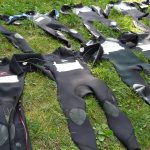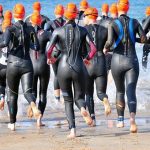If you live in a colder area where the water is only warm for 2-3 months a year, owning a wetsuit allows you to stay active and do the water sports you love year-round.
A wetsuit is a type of clothing that is designed to keep you warm in cold water. It was invented in the early 1900s by a man named Hugh Bradner. Wetsuits are made of neoprene, a type of synthetic rubber.
They are usually black or dark blue in color. Wetsuits are used by surfers, divers, and other people who spend time in cold water.
They help to prevent hypothermia, a condition that can occur when your body temperature drops below 95 degrees Fahrenheit.
The History of Wetsuits
A wetsuit was first designed between 1927 and 1929 by Thomas Edgar Aud of Herndon, Virginia. This initial design was more similar to a dry suit than a neoprene wetsuit.
In Aud’s notes, it states that the material used for the suit is strong, durable, and waterproof. It is also designed to be easily put on and taken off, and it will effectively prevent water from entering.
Up until that point, neoprene had not been discovered, but it was found in 1930.
Hugh Bradner, a physicist who worked for the US Navy in 1951, designed the modern-day neoprene suit as an insulated suit that keeps your body’s temperature high enough to prevent hypothermia when in water.
Hugh discovered that the cellular structure of neoprene made it a superb material for wetsuits, which became popular among water sports lovers in 1952.
How Clothing Warms Us Up
Wetsuits are made up of layers in order to trap heat and keep the wearer warm. This idea came from the way people dress in colder weather, where wearing multiple thin layers is more effective than one thick layer.
The thin layers trap heat and prevent the body from cooling down.
Why Does Layering Work?
Heat flows from warmer objects to colder ones, not vice versa. So if you’re standing outside in cold weather, heat will flow from your body into the cold air, cooling you off quickly. The same happens with water.
When you’re in cold water, your body starts to cool off rapidly. The rate of cooling depends on the difference between your body temperature and the temperature of your surroundings.
So, the colder the water, the faster you lose energy.
Trapping warm air between layers of clothing or materials is called insulation. This helps to keep people or buildings warm by trapping heat inside.
Trapping warmth.
If you’re not used to swimming in water that is colder than 37°C, it can be quite a shock to your system. Wetsuits are made of neoprene, which is a rubber-like material, and can help keep you warm in colder water, depending on how thick the suit is. The thicker the suit, the colder the water can be.
Buoyancy.
The wetsuits also have air bubbles that help keep you warm. The air bubbles make it so you float on the water easily, which makes it easier to swim faster.
Higher hydrodynamics.
The wetsuits have a coating of SCS or Super Composite Skin. This skin repels water from the suit, making the person lighter and faster in the water. If less water is on the person, they will be warmer.
Wetsuits prevent your body from cooling off too much by trapping a layer of water next to your skin. This water is warmed by your body temperature and insulates you from the colder water.
The water surrounding your body when you are swimming carries heat away from your body much more quickly than the same temperature air would. So even if the water is the same temperature as the air, you may feel much colder in the water.
How Does Neoprene Help?
This helps keep your body temperature stable in frigid waters. Why wear a wetsuit? They are constructed with a multiple layering system containing one layer of neoprene which helps keep your body temperature stable in frigid waters.
I’m not particularly good at chemistry. I don’t think it matters to you either, so I won’t go into detail about how carbon-based organic chemicals are made of repeating building blocks called monomers, which trap heat more efficiently than any other material, even rubbers.
neoprene is a type of foam rubber that contains nitrogen gas bubbles. These bubbles make neoprene a good heat insulator.
In warm waters, you don’t need to wear a wetsuit or a shortie (wetsuit cut off at the arms and legs), but in colder water, it’s worth it to wear a full-length wetsuit.
You’ll be glad you did when you’re wearing it 8-9 months out of the year.
Water Temperature and Neoprene Thickness
The key ingredient in wetsuits is neoprene, a stretchy synthetic rubber that’s used in all sorts of things, from hose gaskets to high-fashion clothing. The neoprene in wetsuits is “foamed” with nitrogen to increase its stretchiness and insulating properties.
Some brands of neoprene use a less petroleum-intensive limestone-based manufacturing process. Some wetsuits also use dope-dye yarn, which not only reduces the carbon footprint but also provides better fade resistance.
Neoprene thickness
The thickness of your neoprene suit depends on the water temperature where you surf, swim, or paddle. Neoprene comes in different thicknesses—the thicker the neoprene, the warmer the wetsuit.
When you see a single number next to a wetsuit, it means that the neoprene has one consistent thickness throughout. When you see two numbers next to a wetsuit, it means that the neoprene has two different thicknesses- with the thicker material being used around the core for warmth and buoyancy, and the thinner material being used for the arms and legs for mobility. In some cases, wetsuits may use three or more different thicknesses of neoprene.
There are many guides that give suggested thickness for wetsuits based on temperature, but other factors such as wind, air temperature, personal preference, and how long you’ll be out can also influence the ideal wetsuit thickness for you.
Some wetsuits designed for colder water have an extra layer of soft fabric on the inside for added warmth without increasing bulk from thicker neoprene.
How to Choose a Wetsuit
Wetsuits are often used by surfers, triathletes, and paddlers as they provide warmth and a safety margin in colder waters. Wetsuits work by trapping a thin layer of water next to the skin which the body then heats up, providing a thermal barrier.
The range of options and opinions out there can seem overwhelming, but you can zero in on your ideal wetsuit by thinking about a few things:
- What’s the water temperature?: Get the right wetsuit thickness for the temps you’re in.
- What activity are you doing?: Surfing, swimming, or paddling require unique wetsuit designs.
- Finding the right fit: A wetsuit that fits well keeps extra cold water from getting in (“flushing”) and replacing the body-warmed water already inside.
- Wetsuit design features: Learn how zippers and seams can affect warmth.
- Helpful accessories: Gear to complete the ensemble and keep you warmer.
Wetsuits for different activities
How you intend to use your wetsuit will have a big impact on which wetsuit you decide to buy. Consider your options for surfing, triathlons and open-water swimming, and paddling.
Wetsuits for Surfing
Surfers have a lot of different types of wetsuits to choose from, which are good for different temperatures.
Shorty wetsuits
This style of clothing is also known as a spring suit or shorty. It is cut off at the knees and elbows and is made of relatively thin material. This makes it easy to paddle in. It is great to wear when it is just a bit too chilly to surf in a swimsuit and rashguard.
Full suits
A full wetsuit is a type of wetsuit that is worn by many surfers around the world. They are thicker and more resistant to flushing than shorties. Full wetsuits are generally good for summer sessions in the southern Great Lakes or on
Canada’s east and west coast. Paired with a hood, gloves, and booties, many surfers can also wear a 4/3mm full suit well into the shoulder seasons.
Hooded full suits
A full suit with a neoprene hood is the best option for cold conditions. Some models also have an inner fabric lining for extra warmth. A 5/4 hooded suit will work throughout the year in colder climates, like the west coast or Great Lakes. For winter conditions on Lake Superior, go for a thicker model like a 6/5/4.
Triathlons and Open-Water Swimming
Another advantage of a wetsuit over regular swimwear is that it covers the swimmer’s body, which can be an advantage in colder climates or in water with a large number of dangerous organisms, such as jellyfish, which might attach themselves to the swimmer’s body.
Wetsuits provide warmth, buoyancy and a streamlined profile for swimmers. They can shave off seconds per kilometer in a well-fitted tri suit, so races regulate their design and use.
Full suits with rear zippers are the most popular style, though some athletes (particularly strong swimmers) go for armless designs for improved mobility at the cost of insulation and buoyancy.
Wetsuits cover the swimmer’s body, which can be an advantage in colder climates or in water with a large number of dangerous organisms, such as jellyfish, which might attach themselves to the swimmer’s body.
Tri suits differ from other wetsuits in a few ways:
- They have a slick outer coating that reduces drag in the water.
- They have thicker, buoyant panels of neoprene around the core and thinner, stretchy panels in areas where mobility is most important (like arms and legs).
- Triathlon wetsuits are super flexible, which comes at the cost of durability and ease of use. Putting these suits on is a technique in itself, and you need to take care to avoid nicking or tearing them in the process.
Competitive vs. Recreational Tri Suits
The thickness of neoprene is generally not as important when choosing a wetsuit for open-water swimming as it is for surfing. Instead, look at design features that will help you swim faster and at your skill level.
If you want to improve your chances of winning at triathlons and open-water swim events, choose the most advanced wetsuit that fits your budget. More advanced suits often have tailoring details to improve efficiency and promote good stroke mechanics.
Some add subtle forearm ridges to increase stroke power or tailor the arm fabric to encourage a high elbow at the top of your crawl (many swimmers drop their elbow as fatigue sets in). High-end suits also help you keep a good body position in the water through the careful positioning of different thicknesses of neoprene.
If you are a recreational open-water swimmer, or just starting out in triathlons, an entry-level suit should be all you need.




